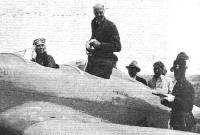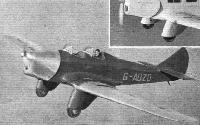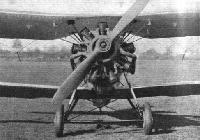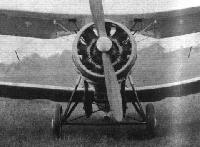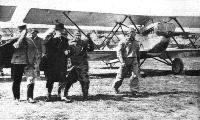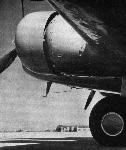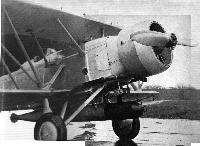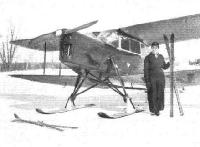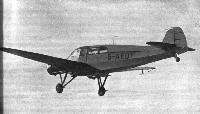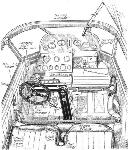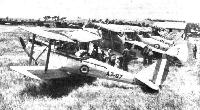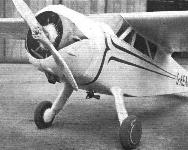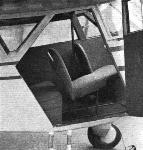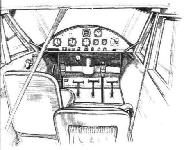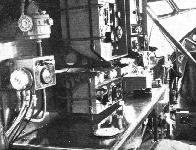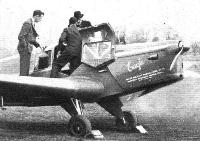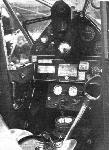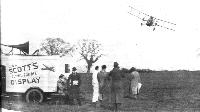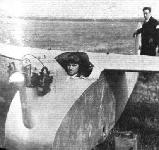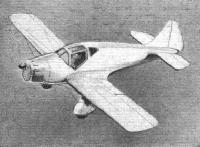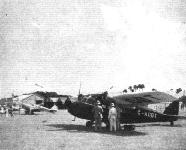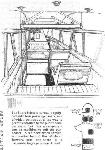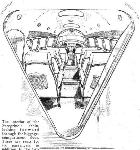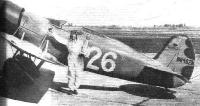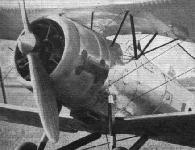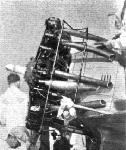Фотографии
-
Регистрационный номер: NX258Y, R258Y The Hughes monoplane, seen here with its 1,000 h.p. Twin Wasp Junior uncowled, holds the world's landplane speed record with 352 m.p.h.
Самолёты на фотографии: Hughes H-1 - США - 1935
-
Регистрационный номер: K4303 [3] Самолёты на фотографии: Fairey Battle - Великобритания - 1936
-
Регистрационный номер: K4303 [3] Самолёты на фотографии: Fairey Battle - Великобритания - 1936
-
Регистрационный номер: K4303 [3] Самолёты на фотографии: Fairey Battle - Великобритания - 1936
-
Major Thornton is a keen private owner who uses his machine for touring at home and abroad. A Liverpool ship-owner by profession, he has no patience with narrow-minded nationalism, especially where it affects air travel. In the snapshot here, he is seen with Mrs. Thornton at last year's Magyar Pilota Picnic, to which he flew in his Hawk Major.
Самолёты на фотографии: Miles Hawk / M.2 - Великобритания - 1932
-
Регистрационный номер: G-ADZZ The Hawk Trainer, which differs only in detail from the standard Major.
Самолёты на фотографии: Miles Hawk / M.2 - Великобритания - 1932
-
Регистрационный номер: K5925 The in-line air-cooled engine permits a clean cowling installation, as typified on the Miles Hawcon (D. H. Gipsy Six) in the Flight photograph.
Самолёты на фотографии: Miles Falcon M.3 / Hawcon M.6 - Великобритания - 1934
-
Регистрационный номер: G-ADLC The Falcon Six - actually the King's Cup winner being flown by Flt. Lt. Rose himself.
Самолёты на фотографии: Miles Falcon M.3 / Hawcon M.6 - Великобритания - 1934
-
In its three-seater form the pilot of the Miles Falcon - in this case the Gipsy Six model - is seated centrally. As a four-seater the third passenger sits beside the pilot, who has the control column on his right. The arrangements for passengers and luggage are shown in the diagram.
Самолёты на фотографии: Miles Falcon M.3 / Hawcon M.6 - Великобритания - 1934
-
A few Bristol installations (reading from top): Bulldog (Jupiter VI with cylinder "tails" and exhaust collector blending into spinner); Bulldog IV (Mercury IV with separate exhaust collector and Townend ring); Bulldog IV (Mercury VI S with combined exhaust collector and Townend ring);
Самолёты на фотографии: Bristol Bulldog - Великобритания - 1927
-
Bulldog IV (showing Perseus sleeve-valve engine uncowled)
Самолёты на фотографии: Bristol Bulldog - Великобритания - 1927
-
Bulldog IV: the complete scalloped cowling
Самолёты на фотографии: Bristol Bulldog - Великобритания - 1927
-
A Farman biplane of the type acquired by Mr. R. G. J. Nash.
Самолёты на фотографии: Farman Farman-30/40 - Франция - 1915
-
MORE DRAGONS' TEETH: Austria's air force, forbidden under treaties, was inspected by Herr Schussnigg during the spring parade in Vienna. The machines seen here are Fiats of the improved C.R.20 type.
Самолёты на фотографии: FIAT CR.20 - Италия - 1926
-
The A.W. XVI (Panther) of a few years ago; it had an inner flange cowl in addition to its Townend ring. This arrangement is not now standard on the two-row Siddeleys.
Самолёты на фотографии: Armstrong Whitworth Scimitar / A.W.16 / A.W.35 - Великобритания - 1931
-
Much pioneer work has been done in the U.S.A. with the enclosing of geared and supercharged engines in long-chord cowlings. This view shows the mounting of one of the 550 h.p. Wasps in a Boeing 247-D.
Самолёты на фотографии: Boeing Model 247 - США - 1933
-
Регистрационный номер: G-ABUC Unrehearsed item: The elderly C.19 Autogiro which visited the Rally lives up to its registration letters.
Самолёты на фотографии: Cierva/Avro C.19 - Великобритания - 1929
-
The Curtiss Condor (two Cyclones) is a particularly quiet transport. This view shows some of the insulating measures - indicated by arrows - which have been taken in its Sperry-proofed cabin.
Самолёты на фотографии: Curtiss Condor 18 - США - 1929
-
An unusual view of a C.30 Autogiro obtained at the moment when it was sinking vertically on to the ground at Hanworth.
Самолёты на фотографии: Cierva/Avro C.30A / Rota - Великобритания - 1932
-
Регистрационный номер: G-ADWG Going On and Coming Off: Mrs. Crossley taxies out in her chequered Tiger Moth, and Mr. Ashley sets down the Autogiro before the crowd.
Самолёты на фотографии: Cierva/Avro C.30A / Rota - Великобритания - 1932De Havilland Tiger Moth / D.H.82 - Великобритания - 1931
-
Typical type used by the Royal Australian Air Force: Westland Wapiti
Самолёты на фотографии: Westland Wapiti - Великобритания - 1927
-
"Controlled cooling" permits an adequate flow of cooling air under such exacting conditions as a sustained climb, but under cruising conditions gives a reduction in both air flow and drag. The left hand view shows the adjustable "skirt" on the N.A.C.A. cowling of a Douglas observation machine. (Twin Wasp Junior engine.)
Самолёты на фотографии: Douglas O-46 - США - 1934
-
The nose of the Blackburn "Shark" "Tiger"-engined T.S.R. biplane, showing how the 18-inch torpedo is carried and how the 760 h.p. 14-cylinder Tiger is fitted with the long-chord Siddeley cowling.
Самолёты на фотографии: Blackburn Shark / B-6 - Великобритания - 1933
-
TRAINING BOAT PILOTS: All pilots who are posted to a flying boat squadron are first sent for a course with the Seaplane Training Squadron at Calshot. The Saro Cloud is used for preliminary training.
Самолёты на фотографии: Saunders-Roe Cloud / A.19 - Великобритания - 1930
-
Регистрационный номер: K5257 CAPITAL: "London" is the type-name of the Saunders-Roe general purpose flying boat now in production for the R.A.F. This picture shows the first machine "off the line" on the new Saro slipway at Cowes. The engines of the "London" are 690 h.p. Bristol Pegasus III moderately supercharged radials: the top speed is 136 m.p.h. Extreme performance was not aimed at, but rather seaworthiness coupled with versatility. It is understood that this particular machine is likely to visit the Stockholm Show.
Самолёты на фотографии: Saunders-Roe London / A.27 - Великобритания - 1934
-
Регистрационный номер: CF-AYO NO TENDERFOOT: The Noorduyn Norseman is a light transport particularly suited to the Canadian market. Its designer, Mr. R. B. C. Noorduyn, has worked, at various periods, with Fokker (America), Bellanca and Pitcairn. With one of the new 420 h.p. Wright Whirlwinds it does 160 m.p.h. as a landplane with a 1,950-lb. payload. The seaplane version does 146 m.p.h. while on skis the machine is capable of 148 m.p.h.
Самолёты на фотографии: Noorduyn C-64 Norseman - Канада - 1935
-
FOR GENERAL PURPOSES AT SEA: A production-type Fairey Swordfish torpedo spotter reconnaisance shipplane (690 h.p. Bristol Pegasus III) during tests over Hayes. The Swordfish performs the duties of both the torpedo bomber and fleet spotter types.
Самолёты на фотографии: Fairey Swordfish - Великобритания - 1934
-
OUTPUT: "It can almost be said that we have reached a position where the primary structure is of secondary importance from the point of view of the man-hours required to build it. It is the installation of equipment which runs away with the time ..." Point is lent to this quotation from a recent Flight leader by this picture of a Fairey Swordfish having its equipment installed.
Самолёты на фотографии: Fairey Swordfish - Великобритания - 1934
-
Регистрационный номер: CF-AYE STREAMLINE SKIS: The first D.H. Rapide to be fitted with skis in Canada. These are, it is believed, the first streamline skis to be fitted to a transport machine and have positive pitching movements about the axle.
Самолёты на фотографии: De Havilland Dragon Rapide / Dominie / D.H.89 - Великобритания - 1934
-
In these three views the main features of a modern baffled installation are readily seen. The first two show the specially shaped "shoulder" which conducts the cooling air out of the "gills"; in the second the inter-cylinder baffles are visible, and the third shows the complete installation. The nose portion forms the exhaust ring. Actually this installation is of one of the 690 h.p. Bristol Pegasus III's in a Douglas D.C.2.
Самолёты на фотографии: Douglas DC-1 / DC-2 / C-32 / C-39 - США - 1933
-
An interior view of the passengers' cabin of the Douglas. D.C.1 "Transport."
Самолёты на фотографии: Douglas DC-1 / DC-2 / C-32 / C-39 - США - 1933
-
A diagramatic representation of the noise level distribution in the cabin of the Douglas D.C.1 cruising at 75-80 per cent full power and carrying twelve passengers but no mail nor baggage.
Самолёты на фотографии: Douglas DC-1 / DC-2 / C-32 / C-39 - США - 1933
-
Регистрационный номер: F-ANKV The lines of Coupe Deutsch racing Caudrons have been preserved to a noticeable extent in the new Goeland light transport.
Самолёты на фотографии: Caudron C.440 / C.445M Goeland - Франция - 1935
-
Регистрационный номер: G-ADZF [2] The Heinkel He.70a, which has been bought by Rolls Royce Ltd. as a flying engine test bed, photographed last week at Croydon. At present it is fitted with the 600/640 h.p. Kestrel V - already a standard unit in the R.A.F. Later this will give place to more "hush hush" types. The excellent form of the nose shows up to advantage in this picture.
Самолёты на фотографии: Heinkel He-70/Не-170 Blitz - Германия - 1932
-
Регистрационный номер: G-ADZF [2] THE ROLLS-HEINKEL: Another view of the He 70a, with Kestrel V engine, which visited Croydon last week on its way to Hucknall from Germany.
Самолёты на фотографии: Heinkel He-70/Не-170 Blitz - Германия - 1932
-
THE GIRL OF THE LIMBERLOST: The first photograph of a D.H. Hornet Moth on skis. It was taken at Limberlost, a popular winter sports resort north of Toronto, and with the machine is Mrs. Lee Murray, wife of Mr. Lee Murray, who manages the Canadian De Havilland Company.
Самолёты на фотографии: De Havilland Hornet Moth / D.H.87 - Великобритания - 1934
-
Регистрационный номер: G-ADIS In its new form the Hornet Moth has a remarkably short take-off and climbs steeply as soon as it is clear of the ground. As may be gathered, both pilot and passenger have an excellent view in the forward hemisphere as well as through the roof light.
Самолёты на фотографии: De Havilland Hornet Moth / D.H.87 - Великобритания - 1934
-
LORD LONDONDERRY, during his tenure of office as Air Minister, was a keen pupil and private owner. He retains his interest and is seen above about to try a D.H. Hornet Moth at Hatfield in company with Mr. Peter de Havilland. The machine is actually the London Aeroplane Club's latest latest acquisition, and not "ADIS."
Самолёты на фотографии: De Havilland Hornet Moth / D.H.87 - Великобритания - 1934
-
The cabin of the D.H. Dragonfly is light and roomy and both soundproofing and ventilation have been carefully studied. If a radio set is required, this is mounted immediately behind the pilot's seat. As will be seen from the diagram, the luggage is carried in a separate compartment which is reached from the outside.
Самолёты на фотографии: De Havilland Dragonfly / D.H.90 - Великобритания - 1935
-
Регистрационный номер: G-AEDY [2] The plan form of the S.T.25 wing is admirably shown in the flying picture. The position of the adjustable landing light in the nose can be seen in the view.
Самолёты на фотографии: General Aircraft Monospar ST-25 Universal - Великобритания - 1935
-
Регистрационный номер: G-AEDY [2] The picture gives a good impression of the wide field of view available for both pilot and passengers.
Самолёты на фотографии: General Aircraft Monospar ST-25 Universal - Великобритания - 1935
-
Регистрационный номер: K8307 FOR BLIND APPROACHES: One of two Monospar S.T.25s which have been equipped for the wireless flight at Farnborough. This machine has full dual control, with a hood for one pilot, Lear direction-finding equipment, Sperry Horizon and directional gyro, a Reid and Sigrist turn indicator, a Kollsman sensitive altimeter and Smith rate of climb indicator.
Самолёты на фотографии: General Aircraft Monospar ST-25 Universal - Великобритания - 1935
-
There is plenty of light in the Monospar cabin and the machine can be flown from either of the two front seats. When used as a four-seater that in the foreground folds away, leaving a wide shelf for luggage which can be reached, if desired, through a separate door.
Самолёты на фотографии: General Aircraft Monospar ST-25 Universal - Великобритания - 1935
-
The control and instrument layout of the new De Luxe model. In its production form the "pull" starters seen below the control wheel will not appear, since the Niagara III engines are fitted with Rotax electric starters
Самолёты на фотографии: General Aircraft Monospar ST-25 Universal - Великобритания - 1935
-
The two sketches on the left show one of the aileron tab balances and the jacking pad beneath the axle, while the new tab trimmers on rudder and elevator can be seen above.
Самолёты на фотографии: General Aircraft Monospar ST-25 Universal - Великобритания - 1935
-
Регистрационный номер: A1-3, A7-67 A Moth and Hawker Demons of the R.A.A.F. The Australian Demons are equipped for bombing as well as for fighting, carry army co-operation gear such as message hooks, and use the Kestrel V engine.
Самолёты на фотографии: De Havilland Gipsy Moth / Moth X - Великобритания - 1928Hawker Demon - Великобритания - 1932
-
HOMEWARD BOUND: C. J. Melrose, with his Heston Phoenix (Gipsy Six) photographed shortly before leaving for Australia. He had an official send-off from Heston last Saturday, Mr. C. F. G. McCann, Agent General for South Australia, and Mr. Pemberton-Billing (who is Mr. Melrose's uncle), being among the well-wishers. The fact that an extremely adverse weather report thereupon caused a postponement came as rather an anti-climax. Actually, Mr. Melrose left on Monday. He is proceeding Australiawards in easy stages, and on arrival will use the Phoenix for charter work; he will also represent the makers, the Heston Aircraft.Co. Ltd.
Самолёты на фотографии: Heston Phoenix - Великобритания - 1935
-
Two doors are provided in the Heston Phoenix and the seating arrangements can be modified according to the use to which the machine is to be put. The luggage compartment at the rear has a separate door and, though both are not shown in the diagram, there are two doors for the cabin.
Самолёты на фотографии: Heston Phoenix - Великобритания - 1935
-
Perhaps one of the best-known racing types in this country is the Percival Mew Gull (200 h.p. Gipsy Six)
Самолёты на фотографии: Percival Mew Gull - Великобритания - 1934
-
The general arrangement of the surprisingly roomy cabin is apparent in this Flight sketch. The small lever on the left of the pilot's seat (although in this case only one set of controls is fitted, dual controls are optional) operates the split trailing-edge flaps.
There is, as will be seen, ample room, and the luggage is stowed in a compartment at the rear of the cabin. The seating plan indicates the very useful width of the two doors.Самолёты на фотографии: Percival Vega Gull / K.1 - Великобритания - 1935
-
Регистрационный номер: G-ADXL [2] Mrs. Crossley, the Display's lady aerobatic pilot, with Master Rice (whose father deals with the publicity) and the Hillson-Praga Baby monoplane.
Самолёты на фотографии: Praga E-114 Air Baby / E-115 / E-117 - Чехословакия - 1934
-
Регистрационный номер: G-ADXL [2] The clean lines and simple design of the Hillson Praga are apparent in this view, which shows also the forward field of view available for the pilot and passenger.
Самолёты на фотографии: Praga E-114 Air Baby / E-115 / E-117 - Чехословакия - 1934
-
Mr. A. J. Richardson, the 74-year-old enthusiast, put his hands up in surrender when a strange biplane "attacked" his Salmson Klemm as he flew it towards his ground at North Walsham, Norfolk; and the biplane's passenger was armed with a camera.
Самолёты на фотографии: Klemm L.25 - L.28 Swallow - Германия - 1927
-
Регистрационный номер: G-ADDH The Beechcraft, though at first glance somewhat odd in appearance, has some excellent features as well as a good performance.
Самолёты на фотографии: Beechcraft Model 17 Staggerwing - США - 1932
-
Регистрационный номер: EI-AAZ American long-distance racing type: the Bellanca Irish Swoop (Twin Wasp Junior).
Самолёты на фотографии: Bellanca 28 Flash - США - 1934
-
Регистрационный номер: G-AEAI [2] The clean lines of the Cessna are admirably shown in this flying picture taken near Croydon.
Самолёты на фотографии: Cessna Airmaster / C-34 / C-38 / C-145 / C-165 - США - 1935
-
Регистрационный номер: G-AEAI [2] Fully cowled and pressure-baffled, the installation of the Warner Super-Scarab is extremely interesting. Note the streamline tyres.
Самолёты на фотографии: Cessna Airmaster / C-34 / C-38 / C-145 / C-165 - США - 1935
-
To be examined in conjunction with the interior sketch, this picture shows how the offside seat is slid back for entry to the pilots' seats.
Самолёты на фотографии: Cessna Airmaster / C-34 / C-38 / C-145 / C-165 - США - 1935
-
In this interior view the standard equipment is shown. The small window on the left can be opened.
Самолёты на фотографии: Cessna Airmaster / C-34 / C-38 / C-145 / C-165 - США - 1935
-
The self-centring tail wheel (left) is sprung and damped. On the right is one of the cantilever undercarriage legs with the fairing cut away to show the means used to prevent the lower portion of the leg from turning in relation to the main body.
Самолёты на фотографии: Cessna Airmaster / C-34 / C-38 / C-145 / C-165 - США - 1935
-
Регистрационный номер: G-ADJT The latest addition to the Avro range of trainers - the 643, which replaces the Club and standard Cadets. Certain modifications have been made to improve the machine from the tuitional standpoint, and the airframe has been strengthened.
Самолёты на фотографии: Avro Cadet / Type 631/643 - Великобритания - 1932
-
The exterior view shows two of the three generators, a landing light and the short and long-wave aerial systems.
Самолёты на фотографии: De Havilland Dragon / D.H.84 - Великобритания - 1932
-
The major part of the equipment of the "Flying Showroom" is arranged immediately behind what is normally the bulkhead of the Dragon. On the left is ths Standard radio compass, while the various details of the other radio equipment are nearer the cockpit.
Самолёты на фотографии: De Havilland Dragon / D.H.84 - Великобритания - 1932
-
An interior view of the rear of the Dragon's cabin with the automatic pilots for the three axes in their transparent covers and the rotating loop for the radio compass.
Самолёты на фотографии: De Havilland Dragon / D.H.84 - Великобритания - 1932
-
THE ONCE-OVER: Colonel Lindbergh inspects the B.A. Eagle prior to making his first flight since he came to England.
Самолёты на фотографии: British Klemm BK-1 Eagle - Великобритания - 1934
-
The Eagle, which, with three occupants and their luggage, cruises at 130 m.p.h.
Самолёты на фотографии: British Klemm BK-1 Eagle - Великобритания - 1934
-
The amount of transparent area is particularly noticeable in this sketch of the interior of the B.A. Eagle. The undercarriage handle can be seen on the right of the pilot's seat, while the diagram shows the seating and luggage arrangements.
Самолёты на фотографии: British Klemm BK-1 Eagle - Великобритания - 1934
-
The modern long-chord cowling is designed in relation to the body behind it. Note in this view of one of Sabena's Savoia Marchettis how the cowling of the fuselage engine increases in diameter toward the rear and how that of the outboard units taper in the opposite sense.
Самолёты на фотографии: Savoia-Marchetti / SIAI S.73 - Италия - 1934
-
Although not absolutely typical, the instrument layout of Lord Sempill's Puss Moth is interesting. It includes an R.T.E homing receiver, while in the centre panel are the Sperry artificial horizon and directional gyro and the homing indicator.
Самолёты на фотографии: De Havilland Puss Moth / D.H.80 - Великобритания - 1929
-
Economical flying is provided by the Light Aircraft Co.'s Aeronca, which carries pilot and passenger on an engine of 40 h.p. only.
Самолёты на фотографии: Aeronca C - США - 1929
-
The cabin arrangements of the Aeronca. It will be seen that, in the present form at least, the throttle is centrally placed. On the right is shown the seating and luggage compartment layout. The side windows can be opened.
Самолёты на фотографии: Aeronca C - США - 1929
-
The Fleet: Miss Joan Meakin's Wolf glider, the Airspeed Ferry, and the B.A.C. Drone are in the foreground.
Самолёты на фотографии: Airspeed Ferry / AS.4 - Великобритания - 1932Goppingen Go.1 Wolf - Германия - 1935Kronfeld Drone - Великобритания - 1932
-
Spring in the Air: Capt. King in the act of giving everyone a close-up of the Airspeed Ferry. One of the smart vans attached to the display is in the foreground.
Самолёты на фотографии: Airspeed Ferry / AS.4 - Великобритания - 1932
-
Avro Baby (35 h.p. water-cooled 4 cyl. Green), as flown non-stop to Turin by the late Bert Hinkler.
Самолёты на фотографии: Avro Baby / Type 534 - Великобритания - 1919
-
ELIMINATING TRIALS AT LYMPNE: 5, Longton planting the Blackburn "Bluebird" in the landing test.
Representative type of the pre-1926 "ultra-light" era: Blackburn Bluebird (75 h.p. 6-cyl. Genet) - the first side-by-side two-seater light aeroplaneСамолёты на фотографии: Blackburn Bluebird / L.1 - Великобритания - 1924
-
Регистрационный номер: NC14716 An impressive flying picture of the first of the three Martin boats designed for long-distance transoceanic work - the China Clipper.
Самолёты на фотографии: Martin China Clipper / Type 130 - США - 1934
-
Регистрационный номер: NR2100 The "teardrop" fuselage of one of the famous Hornet-powered Gee Bees shows up well in this view.
Самолёты на фотографии: Gee Bee Model Z/R Super Sportster - США - 1931
-
The English Electric Company's Wren, which flew strongly on the power of a 400 c.c. A.B.C. motor cycle engine.
Самолёты на фотографии: English Electric Wren - Великобритания - 1923
-
Регистрационный номер: G-ABPI, VT-AEF INDIA'S MODEL AIRPORT BUILDING: This aerial picture, taken by Indian Air Survey and Transport, clearly shows the design of the New Delhi airport building, which was opened by H.E. Lord Willingdon on February 15. It is particularly interesting since it will be the model for several others which are to be built in India and forms a concrete result ot travels of Mr. R. T. Russel and Capt. A. G. Wyatt, who were responsible for the design.
Самолёты на фотографии: Armstrong Whitworth Atalanta / A.W.15 - Великобритания - 1932
-
The D.H. 53 (750 c.c. flat-twin Douglas).
Самолёты на фотографии: De Havilland Humming Bird / D.H.53 - Великобритания - 1923
-
A two-seater cabin machine now in the process of being built - the Marendaz, which is likely to be fitted with a Pobjoy engine.
Самолёты на фотографии: Marendaz Mk III - Великобритания - 1937
-
Регистрационный номер: G-ADDT [3] Самолёты на фотографии: Short Scion / S.16 - Великобритания - 1933
-
Competing machines in the Viceroy's Cup Race lined up on the aerodrome at Bombay. The Scion is fifth in the line.
Самолёты на фотографии: Short Scion / S.16 - Великобритания - 1933
-
Регистрационный номер: G-ADDT [3] The machine being refuelled at Bombay during the race.
Самолёты на фотографии: Short Scion / S.16 - Великобритания - 1933
-
Регистрационный номер: G-ADDT [3] A sunny scene on Madras Aerodrome
Самолёты на фотографии: Short Scion / S.16 - Великобритания - 1933
-
The present Pobjoy cowling is of long chord and incorporates "helmets" for the cylinders. This installation is of a Niagara in a Short Scion
Самолёты на фотографии: Short Scion / S.16 - Великобритания - 1933
-
The Short Scion is normally equipped with four passenger seats, one of which swings out of the way to permit entrance to the pilot' s compartment, but this arrangement can be modified to suit the purchaser. A radio set, when carried, is mounted behind the left-hand forward seat and there is a separate luggage compartment.
Самолёты на фотографии: Short Scion / S.16 - Великобритания - 1933
-
H.H. The Maharajah of Jodhpur trying out the Scion with his personal pilot, Flt. Lt. Godwin, at the controls.
Самолёты на фотографии: Short Scion / S.16 - Великобритания - 1933
-
BACK TO THE LAND: The Boeing 299 makes a finely judged aerodrome approach over a maize field.
Самолёты на фотографии: Boeing B-17 Flying Fortress - США - 1935
-
The Scott Flying Squirrel is particularly suitable for Pou-du-Ciel. At 2,800 r.p.m. (normal) it gives 16 h.p., but at 5,200 r.p.m. the power is 34 h.p.
The 25 h.p. Scott Flying Squirrel engine, a version of the motor cycle engine, was designed expressly for the Flea.Самолёты на фотографии: Mignet Pou-de-Ciel / HM-14 - Франция - 1932
-
Регистрационный номер: G-AEEI Some of the 5,000 spectators getting their money's worth
Самолёты на фотографии: Mignet Pou-de-Ciel / HM-14 - Франция - 1932
-
POWER FOR THE "POU." The new Carden engine installed in a Pou-du-Ciel. Based on the 10 h.p. Ford, it has an aluminium cylinder head and dual ignition. Carden Aero Engines Ltd., of Heston, are to market the engine at ?65.
Самолёты на фотографии: Mignet Pou-de-Ciel / HM-14 - Франция - 1932
-
The Putnam Pou-du-Ciel with Carden engine. Note the window in the wing, which improves the view upwards.
Самолёты на фотографии: Mignet Pou-de-Ciel / HM-14 - Франция - 1932
-
The nose of Mr. C. M. Cooper's machine, which has an Austin Seven engine driving the airscrew through a chain reduction gear.
Самолёты на фотографии: Mignet Pou-de-Ciel / HM-14 - Франция - 1932
-
Регистрационный номер: G-ADPX Putting together the Perman Pou - two snapshots taken within a few minutes of each other. Assembly seemed to be a really quick and simple business.
Самолёты на фотографии: Mignet Pou-de-Ciel / HM-14 - Франция - 1932
-
The interior of the Peregrine's cabin, looking forward through the luggage compartment door. There are seats for six passengers in addition to the two pilots.
Самолёты на фотографии: Miles Peregrine / M.8 - Великобритания - 1936
-
The 750 c.c. Douglas engine of the type used in the Drone.
Самолёты на фотографии: Kronfeld Drone - Великобритания - 1932
-
PROOF: Lord Sempill's flight to Berlin (11 hours) and back (9 hours) in a B.A.C. Super Drone must have given a jolt to those who habitually scoff at ultra-light aircraft. Lord Sempill is seen at Croydon with Mr. Kronfeld (right).
Самолёты на фотографии: Kronfeld Drone - Великобритания - 1932
-
Регистрационный номер: G-AEAN "- nothing up my sleeve." Mr. Idwal Jones demonstrates the docility of the B. A. C. Drone.
Самолёты на фотографии: Kronfeld Drone - Великобритания - 1932
-
Pilot's view of the Super Drone. On the left are the controls, the very full array of instruments and the cockpit layout.
Самолёты на фотографии: Kronfeld Drone - Великобритания - 1932
-
Typical type used by the Royal Australian Air Force: Supermarine Southampton (wooden construction).
Самолёты на фотографии: Supermarine Southampton / Solent - Великобритания - 1925
-
Регистрационный номер: J-BCRO [Nakajima P-1] JAPANESE - WITH A TWANG: This Nakajima biplane carries the night mail between Tokyo and Osaka. Its cruising speed is about 120 m.p.h.
Самолёты на фотографии: Nakajima E4N - Япония - 1930
-
Регистрационный номер: NR482N Mr. "Jimmy" Haizlip with one of the successful Travel Air "R" monoplanes of a few years back. One was seen over here in the hands of Capt. Frank Hawks.
Самолёты на фотографии: Travel Air Type R Mystery Ship - США - 1929
-
Регистрационный номер: G-ADDB The Swallow has an enviable reputation for safe and easy handling.
Самолёты на фотографии: British Klemm L.25 Swallow - Великобритания - 1933
-
Регистрационный номер: G-EBKP Representative type of the pre-1926 "ultra-light" era: Avro Avis (38 h.p., 3-cyl. Blackburne Thrush)
Самолёты на фотографии: Avro Avis / Type 562 - Великобритания - 1924
-
Регистрационный номер: N226 "Helmets" gave a good aerodynamic improvement, but bad cooling. The Short Crusader racing seaplane had its Bristol Mercury similarly cowled. Only one "helmet" is shown in place here.
Самолёты на фотографии: Short Short-Bristol (Short-Bristow) Crusader - Великобритания - 1927
-
Регистрационный номер: J9051 Bullpup (sleeve-valve Aquila with combined long-chord cowling and Townend ring).
Самолёты на фотографии: Bristol Bullpup - Великобритания - 1928
-
Регистрационный номер: G-ACOI, G-ACTW Самолёты на фотографии: De Havilland Moth Major / D.H.60GIII - Великобритания - 1932
-
This can be seen what lay beneath the cowling of the Hornet engine of a Wedell-Williams racer a few years back.
Самолёты на фотографии: Wedell-Williams Model 44 - США - 1930
-
The Wedell-Williams was a favourite mount of Colonel Roscoe Turner, among others.
Самолёты на фотографии: Wedell-Williams Model 44 - США - 1930
-
Roy Minor with Miss Los Angeles, the successful Brown monoplane.
Самолёты на фотографии: Brown Racer / B-1 / B-2 - США - 1932
-
A somewhat unusual cowling was fitted to the Mercury engine of the Bristol 133 fighter.
Самолёты на фотографии: Bristol Bristol 133 - Великобритания - 1934
-
SIMPLIFIED FLYING: Another interesting American result of Mr. Vidal's campaign for simpler aeroplanes - the Campbell and the all-metal pusher monoplane which, with a Ford V8 engine, has a cruising speed of 100 m.p.h. As in the case of the Weick and the Hammond, the machine has a three-wheeled undercarriage, and that there is a very good field of view in the "two place" cabin can be gathered from this Shell Aviation photograph. Note the radiator intake.
Самолёты на фотографии: Campbell Flivver / F - США - 1935
-
Регистрационный номер: NR12048 The Laird biplanes achieved no little success in America a few years ago. This Wasp-powered model broke the continental record in 1931.
Самолёты на фотографии: Laird Solution / Super Solution - США - 1930
-
DUPLICATED: Latest of the British Aircraft Manufacturing Company's developments, the Double Eagle is eventually likely to be of considerable interest to the smaller air line or charter operator. The pilot has a very good view in all essential directions and, with the low-middle-wing arrangement, the passengers, too, will be able to take an interest in earthly matters. The engines are Gipsy Majors.
Самолёты на фотографии: British Aircraft BA.IV Double Eagle - Великобритания - 1936
-
A scale model of the Pemberton Billing Skylark's "skeleton." All joints are welded.
Самолёты на фотографии: Pemberton-Billing P.B.35 Skylark - Великобритания - 1936
-
The Dunstable Dart
Самолёты на фотографии: Dart Pup - Великобритания - 1936
Статьи
- Flight
- Flight Advertisements




